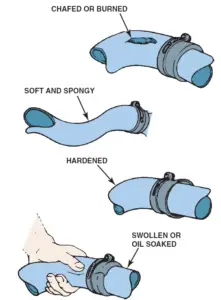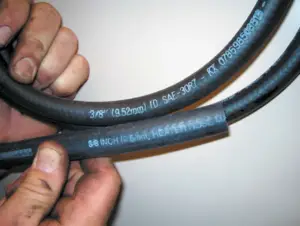Replacing Old Radiator Caps
Replace the old radiator cap with a new cap with the same pressure rating. The cap can be located on the following:
- Radiator
- Coolant recovery reservoir
- Upper radiator hose
Warning
Never remove a pressure cap from a hot engine. When the pressure is removed from the system, the coolant will immediately boil and will expand upward, throwing scalding coolant in all directions. Hot coolant can cause serious burns.

All cooling system hoses should be checked for wear or damage.
Disposing of Used Coolant
Used coolant drained from vehicles should be disposed of according to state or local laws. Some communities permit draining into the sewer. Ethylene glycol will easily biodegrade. There could be problems with groundwater contamination, however, if coolant is spilled on open ground. Check with recycling companies authorized by local or state governments for the exact method recommended for disposal in your area.
Cleaning the Radiator Exterior
Overheating can result from exterior and interior radiator plugging. External plugging is caused by dirt and insects. This type of plugging can be seen if you look straight through the radiator while a light is held behind it. It is most likely to occur on off-road vehicles. The plugged exterior of the radiator core can usually be cleaned with water pressure from a hose. The water is aimed at the engine side of the radiator. The water should flow freely through the core at all locations. If this does not clean the core, the radiator should be removed for cleaning at a radiator shop.
Tech Tip: Always Use Heater Hoses Designed for Coolant
Many heater hoses are sizes that can also be used for other purposes such as oil lines. Always check and use hose that states it is designed for heater or cooling system use.

The top 3/8 in. hose is designed for oil and similar liquids, whereas the 3/8 in. hose below is labeled “heater hose” and is designed for coolant.
Tech Tip: Quick and Easy Cooling System Problem Diagnosis
- If overheating occurs in slow stop-and-go traffic, the usual cause is low airflow through the radiator. Check for airflow blockages or cooling fan malfunction.
- If overheating occurs at highway speeds, the cause is usually a radiator or coolant circulation problem. Check for a restricted or clogged radiator.
Next Steps towards ASE Certification
Now that you’re familiar with Heater Cores: Problem Diagnosis, Inspection, Pressure, and Dye Testing, try out our free Automotive Service Excellence Tests to see how much you know!
![ASE Certification Training HQ - Free ASE Practice Tests [Updated 2021]](https://asecertificationtraining.com/wp-content/themes/simplefolio/images/ASE Certification Logo.png)
